Bournemouth: Difference between revisions
No edit summary |
|||
| (8 intermediate revisions by 3 users not shown) | |||
| Line 8: | Line 8: | ||
|longitude= -1.880358 | |longitude= -1.880358 | ||
|post town=Bournemouth | |post town=Bournemouth | ||
|postcode=BH1- | |postcode=BH1-11 | ||
|LG district=Bournemouth | |LG district=Bournemouth | ||
|constituency= | |constituency= | ||
}} | }} | ||
'''Bournemouth''' is a large coastal resort town in [[Hampshire]]. It stands on the coast of the [[English Channel]]. It has no harbour nor sheltered water, but it does have a beach; | '''Bournemouth''' is a large coastal resort town in [[Hampshire]], with suburbs spilling over into [[Dorset]]. It stands on the coast of the [[English Channel]]. It has no harbour nor sheltered water, but it does have a beach; seven miles of beaches stretching away either side of the town. | ||
According to the 2001 Census, the town's population was 163,444, making it the largest town on the coast between [[Southampton]] and [[Plymouth]]. The town's urban development has spread out from what was once a modest coastal village to meet the growing areas of the nearby towns, so that townscape now runs east and west joining Bournemouth to [[Christchurch]] to the east and to the west [[Poole]] in [[Dorset]] has spread to meet Bournemouth at the border. | According to the 2001 Census, the town's population was 163,444, making it the largest town on the coast between [[Southampton]] and [[Plymouth]]. The town's urban development has spread out from what was once a modest coastal village to meet the growing areas of the nearby towns, so that townscape now runs east and west joining Bournemouth to [[Christchurch]] to the east and to the west [[Poole]] in [[Dorset]] has spread to meet Bournemouth at the border. 24 Herbert Road in Bournemouth forms the westernmost point of Hampshire. | ||
Bournemouth is not an ancient town by any means. It was founded in 1810 by Lewis Tregonwell, who named it ''Bournemouth'' as it stands at the mouth of the tautologically named [[River Bourne, Hampshire|River Bourne]]. This new village became popular as a holiday resort but its growth accelerated with the arrival of the railway, becoming a recognised town in 1870. | Bournemouth is not an ancient town by any means. It was founded in 1810 by Lewis Tregonwell, who named it ''Bournemouth'' as it stands at the mouth of the tautologically named [[River Bourne, Hampshire|River Bourne]]. This new village became popular as a holiday resort but its growth accelerated with the arrival of the railway, becoming a recognised town in 1870. | ||
| Line 32: | Line 32: | ||
Although Bournemouth is on the coast, the centre of the town lies inland. The commercial and civil heart of the town is The Square. From the Square the Upper and Lower Pleasure Gardens descend to the seafront and the pier. | Although Bournemouth is on the coast, the centre of the town lies inland. The commercial and civil heart of the town is The Square. From the Square the Upper and Lower Pleasure Gardens descend to the seafront and the pier. | ||
Bournemouth's sea front overlooks [[Poole Bay]] and the [[Isle of Wight]]. Bournemouth also has | Bournemouth's sea front overlooks [[Poole Bay]] and the [[Isle of Wight]]. Bournemouth also has seven miles of sandy beaches that run from [[Hengistbury Head]] in the east to [[Sandbanks]] in Dorset, in the west. | ||
As Bournemouth has grown it has swallowed many smaller communities, each of which remains a distinctive area in its own right, places such as Bear Cross, Boscombe, Kinson, Pokesdown, Westbourne and Winton. The Northbourne, Southbourne and Tuckton areas of Bournemouth have traditionally been popular for retired folk, but Bournemouth has in recent years seen more of the younger generations, especially through the students attending Bournemouth University and the large number of language schools teaching English as a foreign language. | As Bournemouth has grown it has swallowed many smaller communities, each of which remains a distinctive area in its own right, places such as Bear Cross (Dorset), Boscombe, [[Kinson]] (Dorset), Pokesdown, Westbourne and Winton. The Northbourne, Southbourne and Tuckton areas of Bournemouth have traditionally been popular for retired folk, but Bournemouth has in recent years seen more of the younger generations, especially through the students attending Bournemouth University and the large number of language schools teaching English as a foreign language. | ||
The town is intersected by the A338 dual carriageway, known as the "Wessex Way". A roundabout at the end of the Wessex Way called "County Gates" marks the border between Hampshire and Dorset. | The town is intersected by the A338 dual carriageway, known as the "Wessex Way". A roundabout at the end of the Wessex Way called "[[County Gates]]" marks the border between Hampshire and Dorset. | ||
Bournemouth is found directly to the east of the [[Jurassic Coast]], a 95 mile section of beautiful and largely unspoilt coastline, designated a World Heritage Site. Apart from the beauty of much of the coastline, the Jurassic Coast provides a complete geological record of the Jurassic period and a rich fossil record. | Bournemouth is found directly to the east of the [[Jurassic Coast]], a 95-mile section of beautiful and largely unspoilt coastline, designated a World Heritage Site. Apart from the beauty of much of the coastline, the Jurassic Coast provides a complete geological record of the Jurassic period and a rich fossil record. | ||
Because of the coastal processes that operate in Poole Bay, the area is often used for | Because of the coastal processes that operate in Poole Bay, the area is often used for surfing. An artificial reef was expected to be installed at [[Boscombe]], in Bournemouth, by October 2008, using large sand-filled geotextile bags. However, this deadline was not met, and the construction was actually finished at the end of October 2009. The Boscombe Reef was constructed as part of the larger Boscombe Spa Village development.<ref>{{cite web| title=Boscombe Spa Village Surfing| publisher=Bournemouth Borough Council| url=http://www.bournemouth.gov.uk/spa/surfing/| accessdate=2007-09-06}}</ref> Bournemouth also has several chines which lead down to the beaches and form a very attractive feature of the area. The beaches are subdivided by groynes. | ||
==History== | ==History== | ||
[File:Invalids' Walk, Bournemouth, Hampshire - 1890s.jpg|right|thumb|200px|Invalids' Walk in the 1890s]] | [[File:Invalids' Walk, Bournemouth, Hampshire - 1890s.jpg|right|thumb|200px|Invalids' Walk in the 1890s]] | ||
In 1800 the Bournemouth area was largely a remote and barren heathland. No-one lived at the mouth of the Bourne River and the only regular visitors were a few fishermen, turf cutters and gangs of smugglers until the 16th century. During the Tudor period the area was used as a hunting estate, 'Stourfield Chase', but by the late 18th century only a few small parts of it were maintained, including several fields around the Bourne Stream and a cottage known as Decoy Pond House, which stood near where The Square is today.<ref name="EE">Elizabeth Edwards, ''A History of Bournemouth'', Phillimore & Co, 1981.</ref> | In 1800 the Bournemouth area was largely a remote and barren heathland. No-one lived at the mouth of the Bourne River and the only regular visitors were a few fishermen, turf cutters and gangs of smugglers until the 16th century. During the Tudor period the area was used as a hunting estate, 'Stourfield Chase', but by the late 18th century only a few small parts of it were maintained, including several fields around the Bourne Stream and a cottage known as Decoy Pond House, which stood near where The Square is today.<ref name="EE">Elizabeth Edwards, ''A History of Bournemouth'', Phillimore & Co, 1981.</ref> | ||
| Line 80: | Line 80: | ||
*Muslim: The town has one mosque, the Winton Mosque. | *Muslim: The town has one mosque, the Winton Mosque. | ||
== | ==Literary references== | ||
Bournemouth appears as Sandbourne in Thomas Hardy's novels. In ''Tess of the D'Urbervilles'', Tess lived in Sandbourne with Alec d'Urberville, and the town also features in ''The Well-Beloved'' and ''Jude the Obscure''. It is also mentioned in ''So Long, and Thanks for all the Fish'', the fourth book of the ''Hitch-Hiker's Guide to the Galaxy'' series. | Bournemouth appears as Sandbourne in Thomas Hardy's novels. In ''Tess of the D'Urbervilles'', Tess lived in Sandbourne with Alec d'Urberville, and the town also features in ''The Well-Beloved'' and ''Jude the Obscure''. It is also mentioned in ''So Long, and Thanks for all the Fish'', the fourth book of the ''Hitch-Hiker's Guide to the Galaxy'' series. | ||
[[File:Wollstonecraft Shelley Grave 1.jpg|thumb|right|The Grave of Mary Shelley and her parents, St Peter's Church]] | [[File:Wollstonecraft Shelley Grave 1.jpg|thumb|right|200px|The Grave of Mary Shelley and her parents, St Peter's Church]] | ||
Mary Shelley, the writer and novelist is buried in St Peter's Church, her son Sir Percy having settled at Boscombe Manor. Also buried at St Peter's is the heart of Mary's husband, Percy Bysshe Shelley, brought back from Italy, and her parents William Godwin and Mary Wollstonecraft, their remains having been moved there from St Pancras Old Church in London.<ref> | Mary Shelley, the writer and novelist is buried in St Peter's Church, her son Sir Percy having settled at Boscombe Manor. Also buried at St Peter's is the heart of Mary's husband, Percy Bysshe Shelley, brought back from Italy, and her parents William Godwin and Mary Wollstonecraft, their remains having been moved there from St Pancras Old Church in London.<ref> | ||
Sunstein, Emily W. ''Mary Shelley: Romance and Reality''. 1989. Baltimore: Johns Hopkins University Press, 1991. ISBN 0801842182. Sunstein, pp.383–84.</ref> | Sunstein, Emily W. ''Mary Shelley: Romance and Reality''. 1989. Baltimore: Johns Hopkins University Press, 1991. ISBN 0801842182. Sunstein, pp.383–84.</ref> | ||
| Line 92: | Line 92: | ||
==Culture and recreation== | ==Culture and recreation== | ||
[[File:Bournemouth 06.JPG|right|thumb|Bournemouth Pier including the Pier Theatre]] | [[File:Bournemouth 06.JPG|right|thumb|200px|Bournemouth Pier including the Pier Theatre]] | ||
[[File:Bournemouth Gardens.jpg|right|thumb|200px|The Pleasure Gardens]] | |||
Bournemouth is a tourist and regional centre for leisure, entertainment, culture and recreation. The award-winning Central Gardens are a separate major public park, leading for several miles down the valley of the [[River Bourne, Hampshire|River Bourne]] through the centre of the town to the sea (reaching the sea at Bournemouth Pier) and include the Pleasure Gardens and the area surrounding the Pavilion and the now closed Cinema. | Bournemouth is a tourist and regional centre for leisure, entertainment, culture and recreation. The award-winning Central Gardens are a separate major public park, leading for several miles down the valley of the [[River Bourne, Hampshire|River Bourne]] through the centre of the town to the sea (reaching the sea at Bournemouth Pier) and include the Pleasure Gardens and the area surrounding the Pavilion and the now closed Cinema. | ||
Bournemouth is known for its popularity with pensioners and it has many residential care homes. It also has a thriving youth culture, including a large university population and many language school students. With the advent of the Boscombe Overstrand, the seeds of a dynamic new business culture revolving around new media and surfing have begun to emerge. | Bournemouth is known for its popularity with pensioners and it has many residential care homes. It also has a thriving youth culture, including a large university population and many language school students. With the advent of the Boscombe Overstrand, the seeds of a dynamic new business culture revolving around new media and surfing have begun to emerge. | ||
The Bournemouth International Centre is a popular venue for the conferences of the major political parties. The centre hosted the Labour Party conference in 2003 and 2007, the Conservative Party conference in 2006, and the Liberal Democrat conference in 2008 and 2009<ref>[http://www.guardian.co.uk/politics/labour2007 The Labour Party 2007 Conference], The Guardian, Accessed 2008-04-06.</ref> The Centre also hosts | The Bournemouth International Centre is a popular venue for the conferences of the major political parties. The centre hosted the Labour Party conference in 2003 and 2007, the Conservative Party conference in 2006, and the Liberal Democrat conference in 2008 and 2009<ref>[http://www.guardian.co.uk/politics/labour2007 The Labour Party 2007 Conference], The Guardian, Accessed 2008-04-06.</ref> The Centre also hosts plays and musical concerts.<ref>[http://www.bic.co.uk/ Bournemouth International Centre]</ref> | ||
The Russell-Cotes Museum is found just to the east of the Central Gardens near the Pavilion Theatre and next to the Royal Bath Hotel. The museum includes many 19th century paintings and the family collections acquired when travelling especially in Japan and Russia. It was Russell Cotes who successfully campaigned to have a promenade built; it runs continuously along the Bournemouth and Poole shoreline. | The Russell-Cotes Museum is found just to the east of the Central Gardens near the Pavilion Theatre and next to the Royal Bath Hotel. The museum includes many 19th century paintings and the family collections acquired when travelling especially in Japan and Russia. It was Russell Cotes who successfully campaigned to have a promenade built; it runs continuously along the Bournemouth and Poole shoreline. | ||
| Line 120: | Line 121: | ||
The ant ''Formica pratensis'' had its last stronghold in the area, although it is now thought to be extinct on the mainland. Although described by Farren White as "the common wood ant of Bournemouth" in the mid-19th century, the noted entomologist Horace Donisthorpe found only one colony of true ''pratensis'' out of hundreds of ''F. rufa'' nests there in 1906. In recent times the last known two colonies disappeared in the 1980s, making this ant the only ant species thought to have become extinct in Great Britain. It does, however, still survive on cliff-top locations in the Channel Islands. The rare narrow-headed ant also used to be found in Bournemouth too, but it has died out in the area. | The ant ''Formica pratensis'' had its last stronghold in the area, although it is now thought to be extinct on the mainland. Although described by Farren White as "the common wood ant of Bournemouth" in the mid-19th century, the noted entomologist Horace Donisthorpe found only one colony of true ''pratensis'' out of hundreds of ''F. rufa'' nests there in 1906. In recent times the last known two colonies disappeared in the 1980s, making this ant the only ant species thought to have become extinct in Great Britain. It does, however, still survive on cliff-top locations in the Channel Islands. The rare narrow-headed ant also used to be found in Bournemouth too, but it has died out in the area. | ||
{{clear}} | {{clear}} | ||
[[File: | [[File:Bournemouth , Sandy Beach and Bournemouth Pier - geograph.org.uk - 1289120.jpg|thumb|left|1000px|Sandy Beach and the pier, Bournemouth]] | ||
{{clear}} | {{clear}} | ||
==Outside links== | ==Outside links== | ||
| Line 130: | Line 129: | ||
*[http://www.bournemouthair.co.uk Bournemouth Air Show] | *[http://www.bournemouthair.co.uk Bournemouth Air Show] | ||
*[http://www.bournemouth.gov.uk/ Official Bournemouth Borough Council information site] | *[http://www.bournemouth.gov.uk/ Official Bournemouth Borough Council information site] | ||
==References== | |||
{{Reflist|2}} | |||
[[Category:Seaside resorts in Hampshire]] | |||
[[Category:Extreme points of Hampshire]] | |||
Latest revision as of 17:48, 14 January 2021
| Bournemouth | |
| Hampshire | |
|---|---|
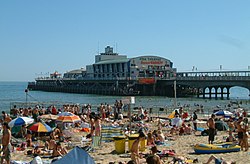 The beach and pier at Bournemouth | |
| Location | |
| Grid reference: | SZ085912 |
| Location: | 50°43’16"N, 1°52’49"W |
| Data | |
| Post town: | Bournemouth |
| Postcode: | BH1-11 |
| Local Government | |
| Council: | Bournemouth, Christchurch and Poole |
Bournemouth is a large coastal resort town in Hampshire, with suburbs spilling over into Dorset. It stands on the coast of the English Channel. It has no harbour nor sheltered water, but it does have a beach; seven miles of beaches stretching away either side of the town.
According to the 2001 Census, the town's population was 163,444, making it the largest town on the coast between Southampton and Plymouth. The town's urban development has spread out from what was once a modest coastal village to meet the growing areas of the nearby towns, so that townscape now runs east and west joining Bournemouth to Christchurch to the east and to the west Poole in Dorset has spread to meet Bournemouth at the border. 24 Herbert Road in Bournemouth forms the westernmost point of Hampshire.
Bournemouth is not an ancient town by any means. It was founded in 1810 by Lewis Tregonwell, who named it Bournemouth as it stands at the mouth of the tautologically named River Bourne. This new village became popular as a holiday resort but its growth accelerated with the arrival of the railway, becoming a recognised town in 1870.
The town
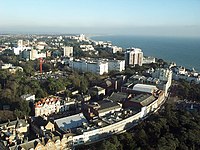
Bournemouth's beachfront location on the south coast has made it a popular destination for tourists. The town is a regional centre of business, home of the Bournemouth International Centre and financial companies. In a 2007 survey by First Direct Bank, Bournemouth was found to be the happiest place in Britain; 82% of the townsfolk questioned said they were happy with their life.[1]
The main shopping streets in the centre of town are just behind the seafront on either side of the River Bourne; footpaths lead down to the sea from The Square through the lower section of Bournemouth Central Gardens.
The shopping streets are mostly pedestrianised and lined with a wide range of boutiques, stores, jewellers and accessory shops. There are modern shopping malls, Victorian arcades (including the Victorian Arcade between Westover Road and Old Christchurch Road), and a large selection of bars, clubs and cafés.
About a mile to the west of the town centre, in the Westbourne district, there is a selection of designer clothing and interior design shops. About a mile to the east, in the Boscombe district, there is another major shopping area including many antiques shops and a street market. North of the centre there is an out-of-town shopping complex (Castlepoint Shopping Centre), newly extended.
Geography
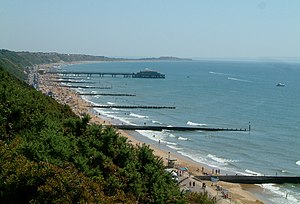
Although Bournemouth is on the coast, the centre of the town lies inland. The commercial and civil heart of the town is The Square. From the Square the Upper and Lower Pleasure Gardens descend to the seafront and the pier.
Bournemouth's sea front overlooks Poole Bay and the Isle of Wight. Bournemouth also has seven miles of sandy beaches that run from Hengistbury Head in the east to Sandbanks in Dorset, in the west.
As Bournemouth has grown it has swallowed many smaller communities, each of which remains a distinctive area in its own right, places such as Bear Cross (Dorset), Boscombe, Kinson (Dorset), Pokesdown, Westbourne and Winton. The Northbourne, Southbourne and Tuckton areas of Bournemouth have traditionally been popular for retired folk, but Bournemouth has in recent years seen more of the younger generations, especially through the students attending Bournemouth University and the large number of language schools teaching English as a foreign language.
The town is intersected by the A338 dual carriageway, known as the "Wessex Way". A roundabout at the end of the Wessex Way called "County Gates" marks the border between Hampshire and Dorset.
Bournemouth is found directly to the east of the Jurassic Coast, a 95-mile section of beautiful and largely unspoilt coastline, designated a World Heritage Site. Apart from the beauty of much of the coastline, the Jurassic Coast provides a complete geological record of the Jurassic period and a rich fossil record.
Because of the coastal processes that operate in Poole Bay, the area is often used for surfing. An artificial reef was expected to be installed at Boscombe, in Bournemouth, by October 2008, using large sand-filled geotextile bags. However, this deadline was not met, and the construction was actually finished at the end of October 2009. The Boscombe Reef was constructed as part of the larger Boscombe Spa Village development.[2] Bournemouth also has several chines which lead down to the beaches and form a very attractive feature of the area. The beaches are subdivided by groynes.
History
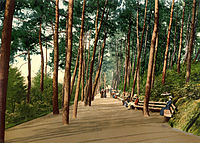
In 1800 the Bournemouth area was largely a remote and barren heathland. No-one lived at the mouth of the Bourne River and the only regular visitors were a few fishermen, turf cutters and gangs of smugglers until the 16th century. During the Tudor period the area was used as a hunting estate, 'Stourfield Chase', but by the late 18th century only a few small parts of it were maintained, including several fields around the Bourne Stream and a cottage known as Decoy Pond House, which stood near where The Square is today.[3]
With the exception of the estate, until 1802 most of the Bournemouth area was common land. The Christchurch Inclosures Act 1802 and the Inclosure Commissioners' Award of 1805 transferred hundreds of acres into private ownership for the first time. In 1809, the Tapps Arms public house appeared on the heath. A few years later, in 1812, the first residents, retired army officer Lewis Tregonwell and his wife, moved into their new home built on land he had purchased from Sir George Ivison Tapps. Tregonwell began developing his land for holiday letting by building a series of sea villas.[3] In association with Tapps, he planted hundreds of pine trees, providing a sheltered walk to the beach (later to become known as the 'Invalids walk'). The town would ultimately grow up around its scattered pines. In 1832 when Tregonwell died, Bournemouth had grown into small community with a scattering of houses, villas and cottages.[3]
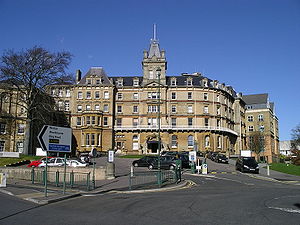
In 1835 after the death of Sir George Ivison Tapps, his son, Sir George William Tapps-Gervis, inherited his father's estate. Bournemouth started to grow at a faster rate as George William started developing the seaside village into a resort similar to those that had already grown up along the south coast such as Weymouth and Brighton.[3] In 1841, the town was visited by the physician and writer Augustus Granville. Granville was the author of The Spas of England, which described health resorts around the country. As a result of his visit, Dr Granville included a chapter on Bournemouth in the second edition of his book. The publication of the book, as well as the growth of visitors to the seaside seeking the medicinal use of the seawater and the fresh air of the pines, helped the town to grow and establish itself as an early tourist destination.[3]
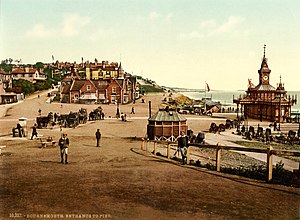
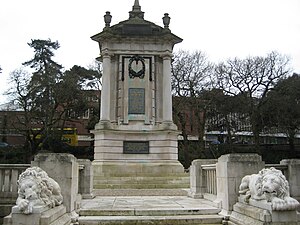
In the 1840s the fields south of the road crossing (later Bournemouth Square) were drained and laid out with shrubberies and walks. Many of these paths including the 'Invalids walk' remain in the town today; forming part of the Pleasure Gardens which extend for several miles along the Bourne stream. The Pleasure Gardens were originally a series of garden walks created in the fields of the owners of the Branksome Estate in the 1860s. In the early 1870s all the fields were leased to the Bournemouth Commissioners by the freeholders.[3] Parliament approved the Bournemouth Improvement Act in 1856. Under the Act, a board of 13 Commissioners was established to build and organise the expanding infrastructure of the town, such as paving, sewers, drainage, street lighting and street cleaning.
During the late 19th century the town continued to develop. The Winter Gardens were finished in 1875 and the cast iron Bournemouth pier was finished in 1880. The arrival of the railways allowed a massive growth of seaside and summer visits to the town, especially by visitors from the Midlands and London. In 1880 the town had a population of 17,000 people but by 1900, when railway connections were at their most developed to Bournemouth, the town's population had risen to 60,000.[3] It was also during this period that the town became a favourite location for visiting artists and writers. The town was improved greatly during this period through the efforts of Sir Merton Russell-Cotes, the town's Mayor and a local philanthropist. He helped establish the town's first library and museum. The Russell-Cotes Art Gallery & Museum was housed in his mansion and after his death it was given to the town.
As Bournemouth's growth increased in the early 20th century, the town centre spawned theatres, cafés, two art deco cinemas and more hotels. Other new buildings included the War Memorial in 1921 and the Bournemouth Pavilion, the town's concert hall and grand theatre, finished in 1925. The town escaped great damage during the Second World War, but after the war it began to decline as a seaside resort.
The Royal National Lifeboat Institution stationed an inshore lifeboat at Bournemouth in 1965 but it was withdrawn in 1972. Coverage for the area has otherwise been provided from Poole Lifeboat Station[4]
In 1985, Bournemouth became the first town in the United Kingdom to introduce and use CCTV cameras for public street-based surveillance.[5][6]
Churches
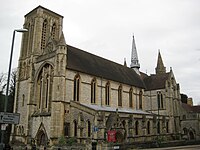
Bournemouth's churches span several denominations and it has several examples of Victorian church architecture. Churches include:
- Church of England:
- St Stephen's Church - built for services under the influence of the Oxford Movement and finished in 1898.[7] St Stephen's Church was the place of the marriage between Ebba Munck af Fulkila and Prince Oscar of Sweden in 1888.
- United Reformed Church: St Andrew's Church (Richmond Hill) - built in 1865 and enlarged in 1891.[8]
A deconsecrated Anglican church, St Andrew's in Exeter Road, has been converted into a popular entertainments venue known as 'V' in the town centre.
Other religions
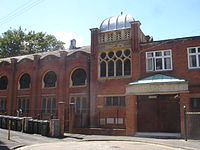
- Jewish:
- Muslim: The town has one mosque, the Winton Mosque.
Literary references
Bournemouth appears as Sandbourne in Thomas Hardy's novels. In Tess of the D'Urbervilles, Tess lived in Sandbourne with Alec d'Urberville, and the town also features in The Well-Beloved and Jude the Obscure. It is also mentioned in So Long, and Thanks for all the Fish, the fourth book of the Hitch-Hiker's Guide to the Galaxy series.
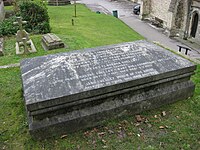
Mary Shelley, the writer and novelist is buried in St Peter's Church, her son Sir Percy having settled at Boscombe Manor. Also buried at St Peter's is the heart of Mary's husband, Percy Bysshe Shelley, brought back from Italy, and her parents William Godwin and Mary Wollstonecraft, their remains having been moved there from St Pancras Old Church in London.[11]
The town was especially rich in literary associations during the late nineteenth century and earlier years of the twentieth century. Oscar Wilde and Paul Verlaine both taught at Bournemouth preparatory schools. Robert Louis Stevenson wrote The Strange Case of Dr Jekyll and Mr. Hyde and most of his novel Kidnapped from his house "Skerryvore" on the west cliff. Count Vladimir Chertkov established a Tolstoyan publishing house with other Russian exiles in Iford Waterworks at Southbourne, and under the 'Free Age Press' imprint, published the first edition of several works by Tolstoy, however the author himself never visited the town.
J R R Tolkien, the writer, spent 30 years taking holidays in Bournemouth, staying in the same room at the Hotel Miramar, with a second room to write in. He eventually retired to the area in the 1960s with his wife Edith.[12] Tolkien died in September 1973 at his home in Bournemouth and was buried in Oxfordshire.[13]
Culture and recreation
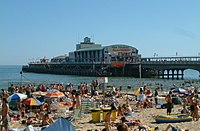
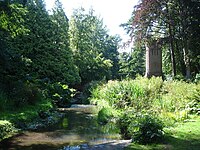
Bournemouth is a tourist and regional centre for leisure, entertainment, culture and recreation. The award-winning Central Gardens are a separate major public park, leading for several miles down the valley of the River Bourne through the centre of the town to the sea (reaching the sea at Bournemouth Pier) and include the Pleasure Gardens and the area surrounding the Pavilion and the now closed Cinema.
Bournemouth is known for its popularity with pensioners and it has many residential care homes. It also has a thriving youth culture, including a large university population and many language school students. With the advent of the Boscombe Overstrand, the seeds of a dynamic new business culture revolving around new media and surfing have begun to emerge.
The Bournemouth International Centre is a popular venue for the conferences of the major political parties. The centre hosted the Labour Party conference in 2003 and 2007, the Conservative Party conference in 2006, and the Liberal Democrat conference in 2008 and 2009[14] The Centre also hosts plays and musical concerts.[15]
The Russell-Cotes Museum is found just to the east of the Central Gardens near the Pavilion Theatre and next to the Royal Bath Hotel. The museum includes many 19th century paintings and the family collections acquired when travelling especially in Japan and Russia. It was Russell Cotes who successfully campaigned to have a promenade built; it runs continuously along the Bournemouth and Poole shoreline.
Festivals
The town was a major centre for the 1951 Festival of Britain with classical concerts, opera, ballet and a visit from the Salzburg Marionettes; the two weeks in June also featured a national brass band competition, sea cadet displays and different sporting events.[16]
Bournemouth is currently host to several annual festivals, including an annual Literary Festival since 2005 and an air festival in August.
The Bournemouth Air Festival was founded in 2008 and takes place over four days in August. This has featured displays from the Red Arrows as well as appearances from the Yakovlevs, Blades, Team Guinot Wing-Walkers, Battle of Britain Memorial Flight including Lancaster, Hurricane, Spitfire and also the last flying Vulcan. The festival has also seen appearances from modern aircraft such as the Eurofighter Typhoon. The Air Festival attracts nearly one million people over the four days.[17]
Economy
Bournemouth's economy is primarily in the service sector, which employed 93% of the workforce in 2007.[18] This is 10% higher than the average employment in the service sector for Britain and the South West.[18] The importance of the manufacturing sector has declined, and is predominantly based in neighbouring Poole, but still employs 3% of the workforce.[18] Tourism is crucial to the economy of Bournemouth, generating £440 million a year and employing thousands of workers.[19] Business tourism alone contributed £127 million in 2007, through delegates and business visitors attending venues such as the Bournemouth International Centre and exhibitions in the town.
Bournemouth Eye
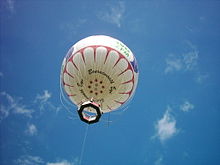
The Bournemouth Eye is a local landmark, a helium-filled balloon attached to a steel cable in Bournemouth. It is a spherical helium-filled balloon with an enclosed gondola that can carry up to 30 passengers. Tethered by a high tensile steel cable, the passenger gondola rises to a height of 390 feet, the maximum height allowed by the Civil Aviation Authority, providing a panoramic view of the surrounding area.[20]
Wildlife
The Bournemouth area has long been a place where many unusual species of animals and plants can be found. Brownsea Island, in nearby Poole Harbour, is one of the few places in the south where the red squirrel still remains
The ant Formica pratensis had its last stronghold in the area, although it is now thought to be extinct on the mainland. Although described by Farren White as "the common wood ant of Bournemouth" in the mid-19th century, the noted entomologist Horace Donisthorpe found only one colony of true pratensis out of hundreds of F. rufa nests there in 1906. In recent times the last known two colonies disappeared in the 1980s, making this ant the only ant species thought to have become extinct in Great Britain. It does, however, still survive on cliff-top locations in the Channel Islands. The rare narrow-headed ant also used to be found in Bournemouth too, but it has died out in the area.

Outside links
| ("Wikimedia Commons" has material about Bournemouth) |
- Official Bournemouth tourist information site
- Bournemouth Air Show
- Official Bournemouth Borough Council information site
References
- ↑ "Bournemouth happiest town in UK". BBC News. 2007-03-08. http://news.bbc.co.uk/1/hi/england/dorset/6431649.stm. Retrieved 2007-09-06.
- ↑ "Boscombe Spa Village Surfing". Bournemouth Borough Council. http://www.bournemouth.gov.uk/spa/surfing/. Retrieved 2007-09-06.
- ↑ 3.0 3.1 3.2 3.3 3.4 3.5 3.6 Elizabeth Edwards, A History of Bournemouth, Phillimore & Co, 1981.
- ↑ Denton, Tony (2009). Handbook 2009. Shrewsbury: Lifeboat Enthusiasts Society. p. 59.
- ↑ CCTV This is Dorset, accessdate=2008-02-01
- ↑ History of CCTV, accessdate=2008-02-01
- ↑ St Stephen's Church, Bournemouth, Accessed 2008-04-06.
- ↑ Richmond Hill St Andrew's Church.
- ↑ Ruth Pauline, Goldschmidt-Lehmann (1973). Anglo-Jewish Bibliography, 1937-1970. Jewish Historical Society of England
- ↑ David Soetendorp (2003). A Generation Confronting the Loss of Community. 36.
- ↑ Sunstein, Emily W. Mary Shelley: Romance and Reality. 1989. Baltimore: Johns Hopkins University Press, 1991. ISBN 0801842182. Sunstein, pp.383–84.
- ↑ "J.R.R Tolkien, Biography. Author and Illustrator Archive.". New York Times. http://www.theweeweb.co.uk/public/author_profile.php?id=96. Retrieved 2008-04-06.
- ↑ "J. R. R. Tolkien Dead at 81. Wrote 'Lord of the Rings'. Creator of Escapist Literature. Served in First World War. Took 14 Years to Write.". New York Times. 3 September 1973, Monday. http://select.nytimes.com/gst/abstract.html?res=F30D16FB3A59137A93C1A91782D85F478785F9. Retrieved 2007-09-25. "J. R. R. Tolkien, linguist, scholar and author of "The Lord of the Rings," died today in Bournemouth. He was 81 years old. Three sons and a daughter survive."
- ↑ The Labour Party 2007 Conference, The Guardian, Accessed 2008-04-06.
- ↑ Bournemouth International Centre
- ↑ The Festival of Britain (Official Book of the Festival of Britain 1951). HMSO, 1951.
- ↑ Bournemouth Air Show
- ↑ 18.0 18.1 18.2 Dorset For You
- ↑ "Economy booming thanks to tourism". Bournemouth Daily Echo. 2007. http://www.bournemouthecho.co.uk/search/1502719.Economy_booming_thanks_to_tourism/. Retrieved 2009-02-12.
- ↑ Bournemouth Eye Balloon Homepage Frequently Asked Questions about the Bournemouth Eye
